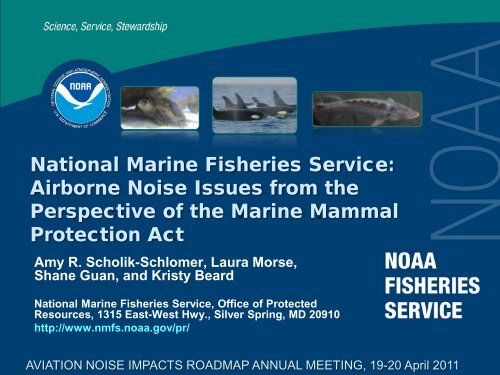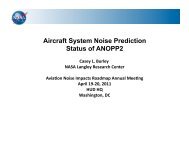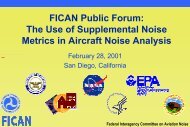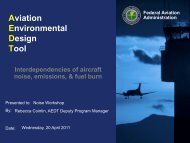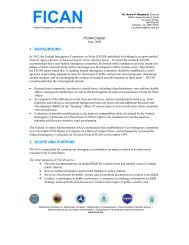National Marine Fisheries Service: Airborne Noise Issues ... - FICAN
National Marine Fisheries Service: Airborne Noise Issues ... - FICAN
National Marine Fisheries Service: Airborne Noise Issues ... - FICAN
You also want an ePaper? Increase the reach of your titles
YUMPU automatically turns print PDFs into web optimized ePapers that Google loves.
<strong>National</strong> <strong>Marine</strong> <strong>Fisheries</strong> <strong>Service</strong>:<br />
<strong>Airborne</strong> <strong>Noise</strong> <strong>Issues</strong> from the<br />
Perspective of the <strong>Marine</strong> Mammal<br />
Protection Act<br />
Amy R. Scholik-Schlomer, Laura Morse,<br />
Shane Guan, and Kristy Beard<br />
<strong>National</strong> <strong>Marine</strong> <strong>Fisheries</strong> <strong>Service</strong>, Office of Protected<br />
Resources, 1315 East-West Hwy., Silver Spring, MD 20910<br />
http://www.nmfs.noaa.gov/pr/<br />
AVIATION NOISE IMPACTS ROADMAP ANNUAL MEETING, 19-20 April 2011
<strong>National</strong> <strong>Marine</strong> <strong>Fisheries</strong><br />
<strong>Service</strong>, Office of Protected<br />
Resources (NMFS OPR)<br />
NMFS OPR works to: conserve, protect, & recover<br />
protected marine species<br />
2
<strong>Marine</strong> Mammal Species<br />
Under NMFS Jurisdiction<br />
<strong>Marine</strong> Mammals (~62 species in U.S.<br />
waters)<br />
• Cetaceans: Baleen Whales<br />
• Cetaceans: Toothed Whales<br />
• Pinnipeds: Seals & Sea Lions (in air & in water)<br />
USFWS Jurisdiction: Walrus, polar bear, sea<br />
otter, & manatee<br />
3
<strong>Marine</strong> Mammal<br />
Protection Act<br />
<strong>Marine</strong> Mammal Protection Act of 1972 (MMPA) :<br />
Afford protection of all marine mammal species<br />
regardless of the species status.<br />
MMPA applies to all persons subject to U.S.<br />
jurisdiction, including on the high seas.<br />
MMPA establishes a moratorium on the “taking” of<br />
marine mammals, except via exemption:<br />
• Subsistence harvest by Alaska Natives<br />
• Incidental commercial fishery interactions<br />
• Incidental take (non-fishing activities)<br />
• Scientific research, public display, and photography<br />
4
MMPA<br />
The term take means to harass, hunt, capture, or kill<br />
or attempt to harass, hunt, capture or kill any marine<br />
mammal<br />
The term harassment means any act of pursuit,<br />
torment, or annoyance which-<br />
• Has the potential to injure a marine mammal or marine<br />
mammal stock in the wild (Level A Harassment)<br />
• Has the potential to disturb a marine mammal or marine<br />
mammal stock in the wild by causing disruption of behavioral<br />
patterns, including, but not limited to, migration, breathing,<br />
nursing, breeding, feeding, or sheltering but which does not<br />
have the potential to injure a marine mammal or marine<br />
mammal stock in the wild (Level B Harassment)<br />
5
Types of Authorizations<br />
Issued by NMFS OPR<br />
Incidental<br />
• “Incidental" (not intentional) taking of small numbers of<br />
marine mammals by U.S. citizens who engage in a<br />
specified activity (other than commercial fishing) within<br />
a specified geographic region<br />
Directed<br />
• For any proposed marine mammal scientific research<br />
activity that involves take of marine mammals<br />
6
Aircraft <strong>Noise</strong><br />
NMFS primarily deals with underwater sound sources<br />
but airborne sources can be an issue<br />
Sources:<br />
• Transportation<br />
• Military<br />
• Offshore oil & gas<br />
• Recreational flights<br />
• Research<br />
• Whale-watching<br />
7
Pinnipeds<br />
Aircraft & <strong>Issues</strong> with<br />
<strong>Marine</strong> Mammals<br />
• Flushing from beaches/ice (injury/death)<br />
• Behavioral responses (abandon haul-outs/rookeries, etc.)<br />
Cetaceans<br />
• Behavioral responses (e.g., change in dive patterns)<br />
Factors Affecting Response<br />
• Aircraft type (helicopter vs. fixed-winged)<br />
• Altitude & flight patterns (hovering/circling)<br />
• Behavioral context/habitat (variable)<br />
• Visual vs. acoustic<br />
Smultea et al. 2008<br />
8
Example activities<br />
Incidental<br />
• Missile & rocket launches (e.g., Vandenberg AFB & Kodiak<br />
Island)<br />
o <strong>Noise</strong> from launches & associated aircraft<br />
• St. George’s Lighthouse Restoration (Del Norte, CA)<br />
o <strong>Noise</strong> from helicopter approaching lighthouse<br />
Take considered<br />
• Potential impacts to pinnipeds at haul-outs/rookeries<br />
• Level B harassment (primarily determined by altitude)<br />
o In air (re: 20 μPa) RL > 90 dBrms for harbor seals<br />
o In air (re: 20 μPa) RL > 100 dBrms for all other pinniped species<br />
9
Mitigation & Monitoring<br />
Measures<br />
(co-occur w/activity)<br />
To minimize the impacts from airborne sound:<br />
• Time area avoidance<br />
o No launches/approaches during pupping season<br />
• Altitude restrictions<br />
o <strong>Marine</strong> mammal monitoring flights maintain minimum altitude of<br />
500 to 1000 ft.<br />
• Flight pattern restrictions<br />
o No direct approaches of haul-out/rookeries by helicopters<br />
10
Directed<br />
Research permits/authorizations<br />
• Scientific research & professional photography/film making<br />
o Any marine mammal sighted is considered a take if the aircraft<br />
altitude is 1000 ft or below<br />
o Permit (SREP) or authorization (GA LOC)<br />
Aerial viewing guidelines/regulations<br />
• Whale-watching & aerial sightseeing<br />
• Guidelines: vary by region<br />
• Regulations: pertain to Steller sea lions, humpback whales,<br />
North Atlantic right whale (ESA listed species)<br />
• http://www.nmfs.noaa.gov/pr/education/regional.htm<br />
11
Data Gaps<br />
Quantification of received level<br />
Behavioral disruption (complex & variable)<br />
• Pinnipeds vs. cetaceans (sensitive species?)<br />
• Visual vs. acoustic stimuli<br />
• Aircraft type (including unmanned aircraft)<br />
• Altitude, speed, & flight patterns<br />
• Context/behavioral state<br />
• Effects on vocalization<br />
General noise issues: cumulative & population-level<br />
effects<br />
12
Thanks for listening!<br />
Questions?<br />
http://www.nmfs.noaa.gov/pr/acoustics<br />
http://www.nmfs.noaa.gov/pr/permits/<br />
Amy.Scholik@noaa.gov<br />
13


